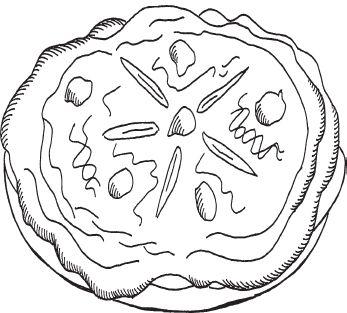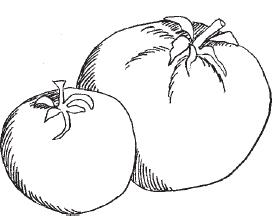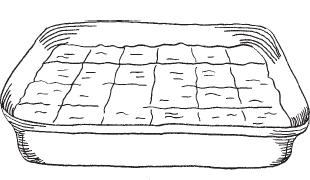Nourishing Traditions: The Cookbook That Challenges Politically Correct Nutrition and The... (144 page)
Authors: Sally Fallon,Pat Connolly,Phd. Mary G. Enig
Tags: #Non-Fiction, #Reference, #Science, #Health
It is recognized that sugar present in chocolate milk, juice, soda, kool-aid, etc., as well as in solid forms, such as candies and cakes, can all interact with gastrointestinal yeasts to form fermentation products.
These fermentation products include alcohol, such as ethanol, as well as mold products. A combination of direct drug effect, as well as chemical intolerance in hypersensitization to mold products, has long been associated with mood changes including what appears to be a mild drunken state, hyperactivity, dyslexia and chemical imbalances that may refer to depression, hyperactivity, mania, etc. Gaynelle D'Arco
Health Freedom News

The second reason I dislike microwave ovens is the more serious situation. What about the quality of the food that comes out of the oven and is immediately consumed—free radicals and all. With the depressed immune system of the average affluent American, the last thing we need is another increase in our free radicals. It is well documented that microwaves are powerful enough to rupture cell walls of the food matrix, and this is undoubtedly why protein molecules are altered from microwave cooking. Warren Clough
PPNF Health Journal

PIZZA TOASTS
Makes 8
8 slices whole grain sourdough bread
4 tablespoons extra virgin olive oil
4 ripe tomatoes
1 teaspoon Italian seasonings
½ cup grated mozzarella cheese
Slice tomatoes about ½-inch thick. Spread on paper towels placed on cookie sheets. Bake at 200 degrees for several hours until most moisture is evaporated or absorbed. Meanwhile, brush bread slices with olive oil, spread on a cookie sheet and bake at 200 degrees for an hour or so until just barely crisp. Arrange tomato slices on bread, sprinkle with seasonings and grated cheese and place under broiler for a minute until cheese just begins to melt.
The most remarkable dish among them, as well as all the other tribes of Indians in those parts, both Chipewyan and Cree, is blood mixed with the half-digested food which is found in the caribou's stomach, and boiled up with a sufficient quantity of water to make it of the consistence of pease-pottage. Some fat and scraps of tender flesh are also shred small and boiled with it. To render this dish more palatable, they have a method of mixing the blood with the contents of the stomach in the paunch itself, and hanging it up in the heat and smoke of the fire for several days; which puts the whole mass into a state of fermentation, which gives it such an agreeable acid taste, that were it not for prejudice, it might be eaten by those who have the nicest palates.
The Journeys of Samuel Hearne
1768
POTATO SKINS
Serves 4
4 large baking potatoes
2 tablespoons melted butter
1 cup grated raw Cheddar or Monterey Jack cheese
1 bunch green onions, finely chopped, for garnish
piima cream or creme fraiche for garnish (
Creme Fraiche
and
Piima Cream
)duck cracklings (
Duck Fat and Cracklings
), optional, for garnishchismole
, optional, for garnishguacamole
, optional, for garnish
Wash and dry potatoes, brush with butter and bake according to master recipe (
Potatoes
) until soft. Split lengthwise and scoop out flesh. (Use flesh for
potato and celery root puree
,
parsnip puree
, or
turnip puree
.) Brush skins with butter, inside and out and bake at 350 degrees for about ½ hour or until skins become crisp. Serve with cheese, cultured cream and optional garnishes.
Venison was a primary part of many of the Native Americans' diet. The deer meat was often roasted on spits, as was wild fowl. Venison was also used to make "pemmican," an early convenience food of the Indians. Pemmican was a mixture of thinly sliced lean venison (or buffalo meat) dried in the sun, pulverized and mixed with melted animal fat and dried berries or cherries. This preparation was packed in sacks of hide, handy to carry. The high-protein mixture would purportedly keep indefinitely. The name comes from the Cree "pemmikkan" associated with their word "pimiy" meaning "grease" or "fat." Northwestern Indians utilized salmon to make a similar concoction. Patricia B. Mitchell
The Good Land
PEMMICAN
Makes 3 cups
3 pounds lean beef, such as brisket or bottom round
1 pound beef suet or tallow
½ cup dried cranberries (optional)
¼ cup maple syrup (optional
Slice beef into thin strips, spread on oiled racks placed on cookie sheets and bake several hours in a 150-degree oven until well dried. (You may also use a dehydrator.) Meanwhile, cut suet or tallow into small pieces and place in a pan. Melt over medium-high heat and allow to boil until any pieces of skin, meat or gristle have become crisp. Pour the hot fat through a strainer into a glass measuring cup—you should have about ¾ cup rendered fat.
Cut dried beef into pieces and process in batches in the food processor, several minutes per batch, until the beef is reduced to a coarse powder. In a bowl, mix powdered beef, warm fat, optional cranberries and optional maple syrup. Press into a quart-sized, wide-mouth mason jar and cover tightly. Pemmican may be stored at room temperature. Eat pemmican as is, or fry it up in a pan.
SALMON JERKY
Makes about 2 cups
1½ pounds fresh salmon, skin removed
½ cup naturally fermented soy sauce
1 teaspoon freshly grated ginger
3 cloves garlic, peeled and crushed
1 teaspoon raw honey or pinch of stevia powder
Mix soy sauce with ginger, garlic and honey or stevia powder. Cut salmon into strips, about
3
/
8
inches by 4 inches. Dip into soy sauce mixture and place on a rack, set over a cookie sheet. Place in a 150-degree oven for about 24 hours or until dehydrated, or dry in a dehydrator. Store in an airtight container in the refrigerator.
Pemmican is controversial. . .a number of scientists are on record that pemmican is good in cold weather, unsuitable in hot climates. But Europeans first encountered this food invention of the Plains Indians in the Texan-Missouri-Dakota-Manitoba sector, where midsummer temperatures go above 120
o
in the shade occasionally and above 100
o
frequently. Pemmican was there chiefly a summer food—because it was a travel food, and journeys were usually made in summer. Its most impressive record as the exclusive diet, or nearly so, of large numbers of men for long periods is from transportation crews of the fur trade working twelve to eighteen hours a day and straight through the noon period with its scorching or steaming heat.
The extreme supporters of pemmican recommend it as the most concentrated food known to man or possible within the modern concepts of physiological and chemical science. They say that it is a complete food in the sense that it will keep a hardworking man in top form for any length of time in any climate. They maintain, indeed, that it is the only concentrated food which ever has been tried out by large numbers of men for long periods which has met these specifications. . ..
There appears to be no disagreement. . .that pemmican is among the most preservable of foods. Cases are on undisputed record where packages, shielded only by rawhide, were in good condition after ten, twenty and more years, without any preservative, such as salt, and without protection. . .other than that given by the leather covering. Vilhjalmur Stefansson
The Fat of the Land
SUNFLOWER SEED BROWNIES
Makes about 18
4 cups hulled sunflower seeds, freshly ground
½ cup carob powder
½ cup Rapadura (see
Guide to Natural Sweeteners
)½ to 1 cup chopped
crispy pecans1 tablespoon vanilla extract
¾ cup filtered water
This unusual brownie recipe contains no flour but is based on ground sunflower seed. It is baked very slowly in the oven so that all the enzymes and antioxidants are preserved. The long period of baking, in which the sunflower meal is warm and moist, also neutralizes enzyme inhibitors. Use a grain mill, fitted with the stainless steel grinder, to grind the sunflower seeds.
Mix sunflower meal with carob powder, Rapadura and nuts. Mix vanilla with water. Pour liquid into sunflower seed mixture and blend well. Dough should be very thick. Line a 9-inch by 13-inch pyrex pan with buttered parchment paper (See
Sources
) and pat dough to a thickness of ½ inch. Bake at 150 degrees for about 12 hours, turn and bake another 12 hours. Allow to cool and cut into squares. Store in an airtight container in the refrigerator.
It's crystal clear that Americans. . .are paying for junk food addiction with their lives. The ones most devastated by the growth of the processed food industry are the populations of the underdeveloped nations. In their insatiable lust for sales, the food monsters are competing for overseas markets. They are pouring millions into Third World advertising campaigns, trying to convince the poor Brazilian farmer that "He Deserves a Break Today," and the starving child of Ghana that "Things Go Better with Coke". . .. The food giants are certainly racking up a lot of victories in the Third World. Two noted food researchers, Frances Moore Lappe and Joseph Collins, have visited the tiny, rotting stores in the rural areas of poor countries and have found chewing gum sold by the stick, Ritz crackers sold one-by-one, and two-packs of Twinkies split up so the awful things can be sold separately. This demand for this poison has been generated by food conglomerate advertising which is doing a great job of teaching people in poor lands "that their traditional diets of beans, corn, millet and rice are worthless as compared to what Americans eat." To the food conglomerates, poor people turning from native, whole foods to processed junk means profit; to the people themselves it means death. Paul Stitt
Fighting the Food Giants
